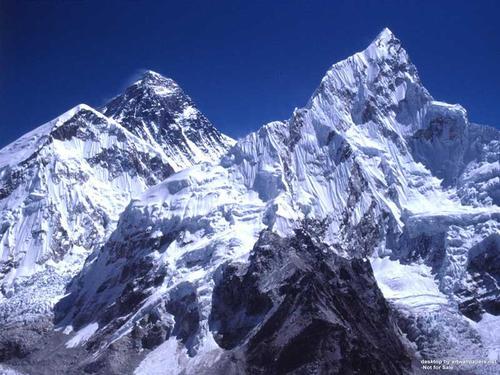Mountaineering is perilous pastime, and many climbers lose their lives every year in bid to summit the peaks of major mountain ranges. While Everest is the Holy Grail for most climbers, there are many other challenges and achievements in the sport. One of the most interesting was a challenge postulated in 1985 by the climber Richard Bass: To summit the highest peaks of each of the seven continents. His idea caught the imagination of the climbing community and many make it a long term goal to complete the seven summits challenge.
Kilimanjaro
The tallest free standing mountain in the world and the tallest in Africa, Kilimanjaro towers above the plains of Tanzania at 5895m above sea level. It is a dormant volcanic mountain. Although not a technical climb, the mountain presents an extreme risk of altitude sickness for even seasoned climbers due its rapid change in elevation on the climbing routes. This makes it very physically demanding; currently, only 41% of all climbers reach the summit. There are six routes mapped for climbers, ranging from the easy Rongai route to the steeper and more scenic Machame. A newer route, the Northern Circuit, allows for a longer climb with better acclimitization. Successful climbers can look forward to viewing the sun rise over the pristine African plain while sitting on the Uhuru peak, the highest point in Africa. Mount Kosciuszko / Puncak Jaya The highest mountain on the Australian mainland continent, Mount Kosciuszko is the smallest of the seven summits at 2228 metres. It is easily summited with even a moderate level of fitness and presents no challenges to a seasoned mountaineer. Another mountain has been put forward to replace it, Puncak Jaya, the tallest island mountain in the world, which is the tallest mountain of Indonesia and Australasia as a whole. It is more than twice the height of Kosciuszko, and is considered to be the most technical climb of the seven summits, if not the most demanding. Puncak Jaya is a remote mountain, requiring five days of hiking from the nearest village to reach its base. Aconcagua The Andes is the physical backbone of South America and the tallest of its mountains is Aconcagua, which rises to 6960m and is the second highest of the seven summits. Like Kilimanjaro, the mountain does not pose a serious technical challenge to climbers; its greatest trial is the elevation, which causes altitude sickness, and the weather, which is very cold with the threat of sudden storms and blizzards. There are multiple routes up the mountain. The northern face climb is the least difficult and does not require climbing gear. Other routes, notably the southern face climb, are very difficult and require great technical expertise. Mount McKinley Also known as Denali, Mount McKinley is North America’s highest peak at 6194m, and the tallest above water, base-to-peak mountain in the world. It is the central point of Denali National Park. While climbing Mount McKinley does require some technical knowledge, is not exceptionally challenging: about 58% of all climbers successfully summit this peak. Its prime danger is its extremely cold weather, with ambient temperature as low as -60oC and wind chill temperatures a staggering -83oC. Storms are also a danger, and in 1967 a twelve-man team was stranded on the summit for ten days, battling blizzards. Seven members of the team perished. Mont Blanc / Elbrus If any mountain can be considered the demi-urge of modern mountaineering, it must be Mont Blanc. It inspired scores of men to climb and gave birth to the art of alpinism. It stands 4810m and its popularity has led to mapping of numerous routes which include every level of difficulty. Prime dangers are the weather, which can change very quickly, and the orography, which is dominated by glaciers and require technical knowledge. It is a very popular mountain and scores flock to climb it. About 100 deaths are recorded every year. Mount Elbrus has been put forward for inclusion on the list as an alternative to Mont Blanc. It is the tallest mountain in Russia at 5642m and cable car system allows for a fit climber to summit the peak in a day, unless a more challenging route is taken. Because of this the peak is generally a far easier climb that Mont Blanc. Mount Elbrus is also said to be home to the world’s “Nastiest Outhouse”. Vinson Massif The tallest mountain on the most extreme of continents. Mountaineers must beware of the dangers of Antartica itself, most notably the cold temperatures. Technical glacier knowledge is a must, as is adequate protection from the weather, for temperatures hover around -30oC at the warmest times of the year. It is one of the most costly mountains to climb due to the expense of travelling to Antartica itself, and the cost of proper outfitting. Mount Everest
Mount Everest, the highest mountain in Asia and the highest in the world at 8848m above sea level, has had its name mispronounced since 1865, when it was named after Sir George Everest (prounounced Eve-rest). To the local Nepali it is Sagamartha (Forehead of the Sky)and to the Tibetans it is Chomolungma (The Mother of the World), and it has been held in religious reverence by both people for centuries. While summiting Mount Everest does not require great technical knowledge on some of the routes, the dangers include sudden blizzards, cold, avalanches and extreme altitude sickness. The upper reaches of mountains are strewn with the bodies of dead mountaineers. For a long time, many believed that it was impossible to summit the peak without supplemental oxygen. Mount Everest was famously first summited by Edmund Hilary and Tenzing Norgay, and those who conquer it can say that they have stood on the highest point on Earth. |


